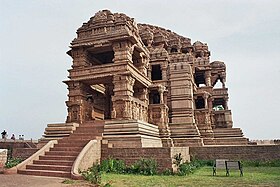Kachchhapaghatas | |||||||||||||
|---|---|---|---|---|---|---|---|---|---|---|---|---|---|
| c. 950 –c.1196 CE[1] | |||||||||||||
The Sasbahu Temple, Gwalior, built in 1096 CE by Kachchhapaghata dynasty ruler Mahipala (r. c. 1090–1105).
| |||||||||||||
Location of the Kachchhapaghata dynasty, and main contemporary South Asian polities in 1175, on the eve of the Ghurid Empire invasion of the subcontinent.[2][3] | |||||||||||||
| Capital | |||||||||||||
| Common languages | Sanskrit | ||||||||||||
| Religion | Hinduism | ||||||||||||
| Government | Monarchy | ||||||||||||
| Historical era | Medieval India | ||||||||||||
• Established | c. 950 | ||||||||||||
• Disestablished | c.1196 CE[1] | ||||||||||||
| |||||||||||||
| Today part of | India | ||||||||||||

Find spots of the Kachchhapaghata inscriptions[4]

The Kachchhapaghatas (IAST: Kacchapaghāta) were a Rajput dynasty that ruled between 10th and 12th centuries.[5] Their territory included north-western parts of Central India (present-day Madhya Pradesh).[6] The Kachhwaha Rajputs of Amber were from the same family.[7]
- ^ Mysore Ramsharma 1970, p. 134.
- ^ Schwartzberg, Joseph E. (1978). A Historical atlas of South Asia. Chicago: University of Chicago Press. p. 37, 147. ISBN 0226742210.
- ^ Eaton, Richard M. (25 July 2019). India in the Persianate Age: 1000–1765. Penguin UK. p. 38. ISBN 978-0-14-196655-7.
- ^ Om Prakash Misra 2003, p. 15.
- ^ "Exploration Of Kadwaha, District Ashoknagar, Madhya Pradesh (2009–2010)". Bhopal: Archaeological Survey of India (Temple Survey Project). Archived from the original on 28 August 2016. Retrieved 9 May 2016.
- ^ Cite error: The named reference
Rahman_2012was invoked but never defined (see the help page). - ^ Wink, André (2002). Al-hind: The Making of the Indo-islamic World. BRILL. p. 287. ISBN 978-90-04-09249-5.


